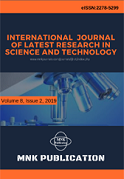DOI:10.29111/ijlrst ISRA Impact Factor:3.35, Peer-reviewed, Open-access Journal
Research Paper Open Access
International Journal of Latest Research in Science and Technology Vol.3 Issue 5, pp 13-17,Year 2014
Correspondence should be addressed to :
Received : 12 September 2014; Accepted : 29 September 2014 ; Published : 31 October 2014

| Download | 126 |
|---|---|
| View | 180 |
| Article No. | 10385 |
Two new types of fossil winged fruits of tribe Engelhardieae (Juglandaceae) are recognized in the Oligocene sediment from the Ningming Basin of Guangxi Province, south China, Palaeocarya guangxiensis sp.nov., and Alfaropsis koreanica (Oishi) Iljinskaya. The Alfaropsis koreanica fossils reported here are from the lowest latitude yet documented for the Oligocene. These fossils augment previously described engelhardioid fruit species from the same locality, Palaeocarya guangxiensis Li et Chen and Palaeocarya ningmingensis Li et Chen providing additional evidence for diversity of Juglandaceae in the Paleogene of South China, and new data for the investigation of the origin and evolution and paleobiogeographical history of the juglandaceous tribe Engelhardieae.
Copyright © 2014 Yunfa Chen et al. This is an open access article distributed under the Creative Commons Attribution 4.0 International (CC BY 4.0) license which permits unrestricted use, distribution, and reproduction in any medium, provided the original work is properly cited.
Yunfa Chen,Steven R. Manchester,Zhuqiu Song, Hongshan Wang , " Oligocene Fossil Winged Fruits Of Tribe Engelhardieae (juglandaceae) From The Ningming Basin Of Guangxi Province, South China ", International Journal of Latest Research in Science and Technology . Vol. 3, Issue 5, pp 13-17 , 2014

MNK Publication was founded in 2012 to upholder revolutionary ideas that would advance the research and practice of business and management. Today, we comply with to advance fresh thinking in latest scientific fields where we think we can make a real difference and growth now also including medical and social care, education,management and engineering.

We offers several opportunities for partnership and tie-up with individual, corporate and organizational level. We are working on the open access platform. Editors, authors, readers, librarians and conference organizer can work together. We are giving open opportunities to all. Our team is always willing to work and collaborate to promote open access publication.

Our Journals provide one of the strongest International open access platform for research communities. Our conference proceeding services provide conference organizers a privileged platform for publishing extended conference papers as journal publications. It is deliberated to disseminate scientific research and to establish long term International collaborations and partnerships with academic communities and conference organizers.